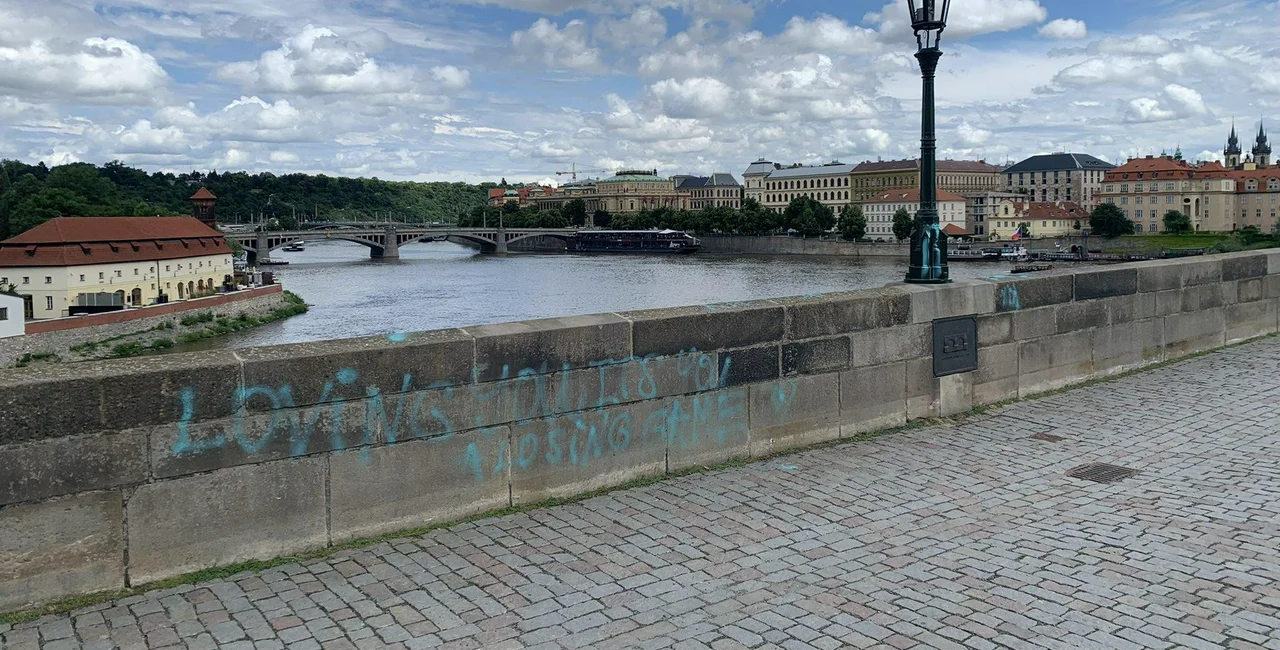A vandal sprayed blue inscriptions on the stone railings of Charles Bridge sometime in the late night of July 8 or early morning of July 9.
Scribbling in English – apparently song lyrics from the Dutch entry in the 2019 Eurovision contest, “Arcade” by Duncan Laurence – was sprayed with a non-washable blue paint, and will need to be professionally cleaned. “Loving you is a losing game,” is the main refrain of the song, which won that year's contest. The song has also recently become popular on social media platform TikTok.
“Prague Police are investigating a case of defacement of the Charles Bridge. At the moment, documentation is being carried out at the site and CCTV footage is being secured. The unknown perpetrator faces up to three years behind bars for the crime of damaging property,” the Czech Police said on Twitter.
Pražštà policisté se zabývajà pÅ™Ãpadem posprejovánà Karlova mostu. V souÄasné chvÃli probÃhá dokumentace na mÃstÄ› a zajiÅ¡Å¥ovánà kamerových záznamů. Neznámému pachateli hrozà za trestný Äin poÅ¡kozenà cizà vÄ›ci až tÅ™i roky za mřÞemi. #policiepha pic.twitter.com/wteJR4iC9K
— Policie ÄŒR (@PolicieCZ) July 9, 2021
The base of a statue and a gas lamp on the bridge were also defaced.
More pictures of the graffiti were posted on Facebook. “I'm sorry, but the beast that sprayed this on the railing and the statue of Charles Bridge would deserve a strong Gothic punishment,” the user said.
“Our colleagues from the Technical Road Administration (TSK) are dealing with the graffiti, and the inscriptions will be probably removed in cooperation with the National Gallery in Prague as one of the tags is on a statue plinth, too,” Prague City Hall spokesman Vít Hofman told the Czech News Agency. (ČTK).
The National Gallery in Prague oversees the statues, as they are considered city-owned public art, while the TSK manages the bridge itself as it is part of the municipal road structure.
The current tags will be removed within several hours, at the most several days depending, on the difficulty of the cleaning. The Prague National Gallery will sent an experienced restorer to deal with the statue plinth, TSK spokeswoman Barbora Lišková said.
There have been several incidents in recent years of vandals attacking Charles Bridge with paint. Many are minor. Before this incident, the most recent was painting on the stairs in May.
One of the largest defacements occurred in July 2019, when two German tourists visiting Prague for a heavy metal concert painted a five-meter-long and two-meter-high logo on one of the bridge supports.
The Prague Municipal Court in December upheld a 12-month suspended sentence to German tourist Benjamin Wittig, who claimed he was only a bystander. The court also upheld a penalty of CZK 100,000 and expulsion from the Czech Republic for five years. He is further appealing the conviction to the Czech Supreme Court.
The same penalty was meted out earlier to his brother Niclas Steiger, who had admitted guilt and accepted the sentence without appeal.
The cleaning of the bridge created another scandal, as an unauthorized professional graffiti cleaner removed the graffiti with a pressure spray, saying the authorities responsible were taking too long, and the delay would cause permanent damage.
The underside of an arch was vandalized in March 2020 with the words "Kraków + Moscow = Prague." The damage was removed quickly. The railing of the bridge was also vandalized in 2016, and two French tourists were eventually identified in that incident.

Today's defacement comes on the 664th anniversary of the start of construction of Charles Bridge. Work began July 9, 1357, at 5:31 in the morning in Old Bohemian time. This created the numerical palindrome 1357, 9.7, 5:31. The significant time was suggested by Emperor Charles IV, who had consulted astrologers.
The Baroque statues were not added until the 17th and 18th centuries, with some final ones added in the 19th century. Most of the statues are now copies.












 Reading time: 3 minutes
Reading time: 3 minutes 























